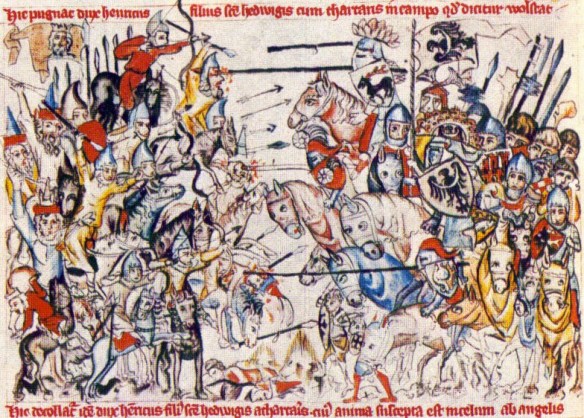Battle of Liegnitz
Following the cataclysm of 1241–1242, King Béla IV of Hungary made efforts to prepare for the next assault, instigating the construction of stone castles on his eastern frontiers and entering into marriage alliances with several of his neighbors, including a Cuman chief whose daughter married his son and heir Stephen (later Stephen V); he also recruited Cumans as auxiliaries. In 1259 Berke’s forces attacked Poland, sacking Sandomir and Kraków, but the splintering of the empire in 1261–1262 prevented the Mongols from following up this campaign. The Golden Horde remained content with exacting tribute and military assistance from the Russian princes and adjudicating their succession disputes. The khans were in any event probably more interested in operations south of the Caucasus at the expense of the Ilkhans than in either Russia or, by extension, Hungary and Poland.
Nevertheless, the Golden Horde remained a hostile power on the frontiers of Latin Christendom. In the Baltic region, the Mongols tended to act through their Russian satellites and the pagan Lithuanians, who paid them tribute intermittently, against external enemies such as the Teutonic Order. Further south the Golden Horde threatened for a time to draw into its orbit further non-Latin polities that might otherwise have succumbed to Latin pressure, such as Bulgaria and the Byzantine Empire. During the heyday of Noghai (d. 1299), a member of the dynasty who was virtually co-ruler in the western regions of the Pontic steppe, Mongol influence extended deep into the Balkans. However, Noghai’s amicable relations with Byzantium did not outlast him, and in the early fourteenth century the khans launched a series of invasions of Thrace. As late as 1341, when the Emperor Andronikos III bought off a Mongol attack, the Golden Horde may still have constituted a greater menace than did the nascent Ottoman polity.
The Mongols dealt with Hungary and Poland more directly. Although there were no further campaigns on the scale of 1241–1242 or 1259, there were frequent raids and also substantial attacks on both countries in the 1280s. The extinction of the client Russian princes of Galicia and Volhynia in 1323 provoked fresh tensions, which were resolved when the new ruler, the Polish prince Bołeslaw of Mazovia, maintained payment of tribute. But after his death (1340), the Mongols reacted sharply to the occupation of Galicia by Kazimierz III of Poland with a series of attacks, and during the middle decades of the fourteenth century, the khan appears to have recruited Lithuanian assistance against him. If Polish appeals to successive popes elicited little or no military aid, they did at least secure the grant of crusading tenths and twentieths rather more readily than did the simultaneous pleas of the Hungarian crown. Around 1360, however, the Golden Horde, already badly hit by the Black Death, succumbed to a prolonged phase of internecine conflict, and the attacks of the conqueror Timur (Tamerlane) in the 1390s dealt its commercial centers a severe blow. The khans were powerless to impede the rise of Lithuania and its appropriation of Russian territory, and by the early fifteenth century they had sunk to being merely auxiliaries in the conflicts of their western neighbors: a Mongol contingent fought at the battle of Tannenberg (1410) alongside the Poles and Lithuanians against the Teutonic Order.
